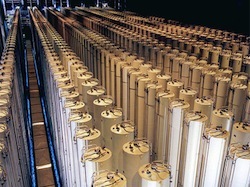Separative Work Units (SWU) and a Final Deal with Iran
JINSA’s Gemunder Center Iran Task Force issues new brief on how a Separative Work Units (SWU) metric as part of a comprehensive agreement could allow Iran to maintain a latent nuclear weapons capability.
Authored by Iran Task Force Co-Chairs Ambassador Eric Edelman and Ambassador Dennis Ross.
Click here to read the full report.
 On July 18, 2014, Iran and the P5+1 agreed to a four-month extension of the Joint Plan of Action (JPA) interim framework for reaching a final deal on Iran’s nuclear program. Negotiators on both sides echoed Secretary John Kerry that “very real gaps” remained on certain parameters of a comprehensive solution.
On July 18, 2014, Iran and the P5+1 agreed to a four-month extension of the Joint Plan of Action (JPA) interim framework for reaching a final deal on Iran’s nuclear program. Negotiators on both sides echoed Secretary John Kerry that “very real gaps” remained on certain parameters of a comprehensive solution.
Talks came to an impasse in large part over the total number and type of centrifuges Iran could keep for uranium enrichment. P5+1 officials have stated they want to roll back Iran’s breakout timing to at least 6-12 months (currently it is around three months), which would require Iran, at the very least, to reduce its number of operating centrifuges. (This breakout timeframe translates to roughly 2,000-4,000 operating IR-1 centrifuges; Iran operates around 10,000 under the JPA.) However, Iranian regime leaders and negotiators have indicated their unwillingness to dismantle any of their nuclear infrastructure, including centrifuges.
Given this apparent deadlock, there are reports negotiators may instead try to limit the total output of Iran’s enrichment facilities, as measured in Separative Work Units (SWU). On July 8 – around the time negotiators were debating centrifuge numbers – the head of Iran’s nuclear program Ali Akbar Salehi said “we don’t define the enrichment needs on the basis of the number of centrifuge machines, but based on their units, meaning SWU.” This echoed comments the day before by Supreme Leader Ali Khamenei which postulated Iran’s enrichment needs in SWU rather than centrifuges.
SWU is a more accurate metric than centrifuge numbers for gauging current enrichment output and breakout timing. However, by itself it is also less effective and reliable as a ceiling on Iran’s total potential enrichment capability. Absent any additional limits – on centrifuge output, numbers and types of operating and installed centrifuges, research and development (R&D) activities, enrichment levels and others – Iran would not have to roll back any of its existing nuclear infrastructure and might still be able to expand and upgrade it. Therefore, a SWU approach could allow Iran to maintain a latent nuclear weapons capability and remain a flip of the switch away from sprinting for the bomb, even while it conforms to a comprehensive agreement on its nuclear program.